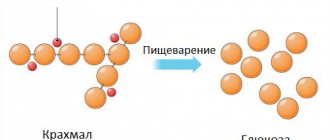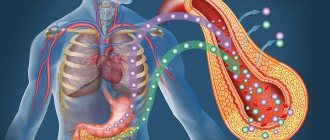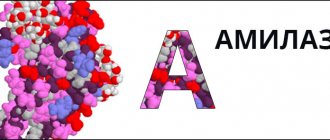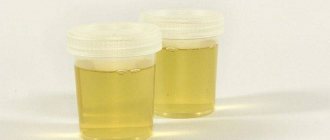general characteristics
Alpha amylase or diastase is a hydrolytic enzyme involved in the digestion of food carbohydrates (decomposes starch and glycogen to maltose). It is formed mainly in the salivary glands and pancreas, then enters the oral cavity or the lumen of the duodenum, respectively. In blood serum, pancreatic and salivary amylase isoenzymes are secreted, respectively. Such organs as the ovaries, fallopian tubes, small and large intestines, and liver also have significantly lower amylase activity. The enzyme is excreted by the kidneys. Therefore, an increase in serum amylase activity leads to an increase in urinary amylase activity. Amylase can form large complexes with immunoglobulins and other plasma proteins, and therefore does not pass through the glomeruli, thus its content in the serum increases, and normal amylase activity is observed in the urine. Since this enzyme is excreted unchanged from the human body by the kidneys, its concentration in the urine makes it possible to determine the functional state of the pancreas, provided that the kidneys are healthy.
Total amylase in daily urine
Amylase is one of several enzymes that are produced in the pancreas and are part of pancreatic juice.
Synonyms Russian
Urine diastasis, urine amylase.
English synonyms
Urine Amy, Urine Alpha-amylase, Urine AML, Urine diastase, Urine amylase.
Research method
Kinetic colorimetric method.
Units
Units/day (unit per day).
What biomaterial can be used for research?
Daily urine.
How to properly prepare for research?
- Do not drink alcohol for 24 hours before the test, and do not drink diuretics for 2 days.
- Eliminate spicy, salty foods and foods that change the color of urine (for example, beets, carrots) from the diet 12 hours before the test.
- Avoid physical and emotional stress during the collection of daily urine (during the day).
General information about the study
Amylase is one of several enzymes that are produced in the pancreas and are part of pancreatic juice. Lipase breaks down fats, proteases break down proteins, and amylase breaks down carbohydrates. From the pancreas, pancreatic juice containing amylase passes through the pancreatic duct into the duodenum, where it helps digest food. The amylase molecule is so small that it can pass through the kidney barrier and then be excreted in the urine.
Normally, only a small amount of amylase circulates in the bloodstream (due to the renewal of salivary and pancreatic cells) and enters the urine. When damage to the pancreas occurs, as in pancreatitis, or if the pancreatic duct is blocked by a stone or tumor, amylase begins to enter the bloodstream in large quantities and then into the urine.
This enzyme is also secreted by the salivary glands, the ducts of which open into the oral cavity. Therefore, its activity in urine may increase with pathology of the salivary glands.
Small amounts of amylase are produced in the ovaries, intestines, bronchi and skeletal muscles.
What is the research used for?
- For the diagnosis of acute or chronic pancreatitis, as well as for identifying other diseases involving the pancreas in the pathological process. As a rule, urine amylase activity corresponds to blood amylase activity, but rises and falls with a delay of 6-10 hours in comparison. After acute pancreatitis, urine amylase activity may remain elevated for up to 7-10 days, in contrast to blood amylase, which usually returns to normal after 2-4 days.
- To monitor treatment for cancer affecting the pancreas.
- To determine the efficiency of the kidneys (compare the activity of amylase in the blood and urine).
When is the study scheduled?
- For symptoms of pancreatic pathology: intense pain in the abdomen and back (“girdling pain”),
- temperature rise,
- loss of appetite,
- vomiting.
What do the results mean?
Reference values: 1 - 408 U/day.
Reasons for increased amylase activity in urine
- Acute pancreatitis. In this disease, amylase activity can exceed the upper reference value by 6-10 times. Typically, its activity in urine increases 6-8 hours after damage to the pancreas and can remain at a high level for up to 2 weeks. However, in some patients with acute pancreatitis, amylase may increase slightly or even remain normal. In general, its activity does not reflect the severity of damage to the pancreas in this disease.
- Chronic pancreatitis. With it, the activity of urine amylase is initially moderately increased, but then it can decrease and return to normal as the damage to the pancreas worsens.
- Trauma to the pancreas.
- Pancreas cancer.
- Blockage (stone, scar) of the pancreatic duct.
- Acute appendicitis, peritonitis.
- Perforation (perforation) of a stomach ulcer.
- Decompensation of diabetes mellitus – diabetic ketoacidosis.
- Impaired drainage in the salivary glands or salivary ducts, such as with mumps (mumps).
- Surgery on the abdominal organs.
- Acute cholecystitis is inflammation of the gallbladder.
- Intestinal obstruction.
- Aborted tubal pregnancy.
- Ruptured aortic aneurysm.
Reasons for decreased amylase activity in urine
- Pancreatic insufficiency, when its function decreases.
- Chronic renal failure.
- Severe hepatitis.
- Cystic fibrosis (cystic fibrosis) of the pancreas is a severe hereditary disease associated with damage to the exocrine glands (lungs, gastrointestinal tract).
- Removal of the pancreas.
- Macroamylasemia is a rare benign condition where amylase binds to large proteins in the serum and therefore cannot pass through the glomeruli.
What can influence the result?
- Urine amylase activity is increased in pregnant women.
- Captopril, corticosteroids, oral contraceptives, furosemide, ibuprofen, and narcotic analgesics can increase amylase activity.
Important Notes
Amylase activity in children is low in the first two months of life; it rises to adult levels only by the end of the first year.
Also recommended
- Serum total amylase
- Milase pancreatic
- Lipase
Who orders the study?
General practitioner, therapist, gastroenterologist, surgeon.
Interpretation:
- Acute, chronic, reactive pancreatitis; pancreatic cyst; blockage of the pancreatic duct (tumor, stone, adhesions); macroamylasemia; parotitis; perforation of a hollow organ; acute peritonitis; diabetes mellitus (ketoacidosis); diseases of the biliary tract (cholelithiasis, cholecystitis); renal failure; abdominal trauma; termination of ectopic pregnancy.
- Pancreatic insufficiency; cystic fibrosis, pancreatectomy; acute and chronic hepatitis; pancreatic necrosis; toxicosis of pregnancy
Sample result (PDF)
When is a biochemical urine test prescribed?
Biochemical urine analysis is used for diagnostic purposes, as well as to monitor the course of the disease and determine the effectiveness of treatment. Indications for urine analysis for biochemistry are:
- kidney and liver diseases;
- inflammatory processes of various localizations;
- rheumatic diseases;
- diabetes;
- suspicions of disturbances in water-salt metabolism and microelements balance.
Features of amylase
If the patient asks the doctor what a urine test for amylase shows, the specialist will note that this study is not mandatory when confirming or refuting the primary diagnosis. However, its implementation makes it possible to assess the level of human health in more detail.
The main indications for laboratory diagnostics are the following conditions:
- There is a possibility of an imbalance in the functioning of the salivary glands located in the area of the ears;
- The patient mechanically injured the pancreas;
- Pancreatitis develops;
- There was damage to the peritoneum;
- Decompensated hyperglycemia progresses;
- The body became infected due to the penetration of viruses.
If a specialist has determined amylase (urinalysis) once, and based on its results he has confirmed the primary diagnosis, then in the future such research will be resorted to more than once. Only in this way will it be possible to fully control the effectiveness of the therapy.
In medicine, several types of enzyme are distinguished. One of them is an enzyme found in animals, the second representative is a plant substance found in wheat. However, alpha-amylase is of particular importance. This enzyme is produced by the organs of external and internal secretion, and also takes an active part in all processes that occur in the intestines and stomach.
The peculiarity of the stomach environment is that complete absorption of starch does not occur here. The substance is absorbed in the body only after it goes through the breakdown stage. For the process to be normal, pancreatin amylase is involved in its participation. As a result of transformations, starch becomes glucose.
The principle of transformation of substances in the body. Source: pptcloud.ruф
When understanding such a method of studying biological fluid of the body as urine analysis for amylase, what it is, it is necessary to note the different levels of enzyme concentration, depending on the time of day. In the evening and at night, the indicators decrease, and during the day they are increased, which affects the quality of the stomach.
That is, if a person prefers night snacks, then he must be prepared for the fact that this will lead to the development of gastritis or ulcers, since fermentation processes are started, because the food does not have time to be digested.
Decoding
The main distinguishing feature of the study is that when conducting it, the laboratory assistant uses starch and iodine, thereby determining the rate of breakdown. For the process to work, it is necessary to heat the starch to 37 degrees, then perform a mixture of different proportions of the two components, after which the changes are compared with the color of the liquid.
Depending on how intense the shade is, the specialist will determine the level of amylase activity. If it is absent from the liquid, the color will remain unchanged. Based on the age limit, the concentration standards will be different: for patients of childhood 600 units, for representatives of the weaker and stronger sex who are already 25 years old within 800 units, for newborns and children of the first year of life no more than 100 units.
As you can understand, the level of concentration does not change depending on gender, it fluctuates only due to age. It is also worth noting that depending on how the study was conducted, amylase levels may differ. If this is morning urine, then in an adult the indicator will be 10-490 units, while in daily urine it will be 10-590 units.
Collection
Do not underestimate the level of information and importance of research of biological materials in the process of making the correct diagnosis. For the results to be correct, urine collection for amylase must be carried out in accordance with all medical recommendations. It is also important to remember that depending on the time of day, the level of concentration of the substance in urine changes significantly.
Depending on the suspected disease or disorder, a specialist may prescribe a study of a morning or daily portion of the material, which is collected taking into account the following nuances:
- About 12 hours before passing urine, salty and spicy foods should be excluded from the diet;
- The day before urine collection, the patient should stop taking strong medications, alcohol and other harmful substances;
- The rules of intimate hygiene must be observed;
- The first part of the morning urine is poured into the toilet;
- For research, only the middle part of urine is taken in a volume of 30 ml;
- The remainder of the biological material is not used.
It is very important to choose a suitable container for collecting urine. It would be better to purchase a sterile container with a lid at the pharmacy. But if you don’t have time for this, then a clean and dry glass container will do.
Patients may also be interested in what a 24-hour urine amylase test is. This is a type of study in which it is necessary to collect urine excreted from the body within 24 hours. You should start accumulating material from eight o'clock in the morning, skipping the first portion (it is completely drained into the toilet) until 8 o'clock the next day.
After this time, you need to mix the container with urine well, and then take no more than 20 ml of urine into a separate container. It is also necessary to indicate on the container what the total volume of biological material collected was. Urine should be stored in a cool place, and no later than two hours after the end of the day, it should be transported to the laboratory.
Increased level of urine diastase
An alpha amylase urine test is prescribed for abdominal pain. It will be increased:
- with pancreatitis. In this case, its indicator increases several times and can reach 128-256 units, despite the fact that the norm is within the range of 16 – 64 units.
- with mumps (inflammation of the salivary glands),
- with cholecystitis (inflammation of the gallbladder),
- with renal failure, diabetes mellitus.
Slightly increased diastasis is determined in acute inflammatory diseases of the abdominal organs (colitis, gastritis, appendicitis, peritonitis).








